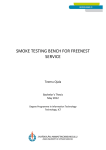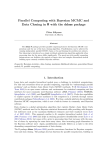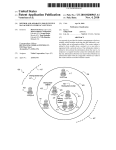Download Centralized system for managing Netem configurations
Transcript
Centralized system for managing
Netem configurations for VyOS/Vyatta
routers
Mikko Neijonen
Bachelor’s thesis
June 2015
Degree programme in Software Engineering
The School of Technology
Description
Author(s)
Neijonen, Mikko
Type of publication
Bachelor’s thesis
Date
5.6.2015
Language of publication:
English
Number of pages
39
Permission for web
publication: yes
Title of publication
Centralized system for managing Netem configurations for VyOS/Vyatta routers
Degree programme
Software engineering
Tutor(s)
Ari Rantala
Assigned by
JAMK University of applied sciences/JYVSECTEC project, Marko Silokunnas
Abstract
This thesis describes a system developed for the RGCE environment for JYVESECTEC
project at JAMK University of Applied Sciences. The system is used to introduce delay and
other such characteristics of wide area networks into RGCE.
Currently RGCE lacks the ability to introduce wide area network characteristics, such as
delay and packet loss, into the environment.
The thesis describes a centralized system for managing Netem configurations on
VyOS/Vyatta routers in a virtual Internet. The implemented system includes a browserbased user interface, a central control server, and the VyOS/Vyatta configuration agents.
The thesis describes the process and problems encountered during the design of the
system. The technical architecture and a text-based application protocol developed for the
system are also described. Finally the solution is evaluated and found suitable for the
intended purpose. It is also concluded that further work is needed to improve the user
interface.
Keywords/tags (subjects)
Netem, network, Linux, configuration management, centralized control, application
protocol
Miscellaneous
Kuvailulehti
Tekijä(t)
Neijonen, Mikko
Julkaisun laji
Päivämäärä
Sivumäärä
Julkaisun kieli
Opinnäytetyö
39
5.6.2015
English
Verkkojulkaisulupa
myönnetty: kyllä
Työn nimi
Centralized system for managing Netem configurations for VyOS/Vyatta routers
Koulutusohjelma
Ohjelmistotekniikan koulutusohjelma
Työn ohjaaja(t)
Ari Rantala
Toimeksiantaja(t)
Jyväskylän ammattikorkeakoulu/JYVSECTEC projekti, Marko Silokunnas
Tiivistelmä
Opinnäytetyö esittelee Jyväskylän Ammattikorkeakoulun JYVSECTEC-projektin hallitsemaan RGCE-ympäristöön kehitettyä järjestelmää viiveiden ja muiden laajaverkon ominaisuuksien tuottamiseksi.
Tällä hetkellä RGCE-ympäristöstä puuttuu laajaverkolle ominaiset häiriötekijät, kuten viiveet ja pakettihäviö.
Opinnäytetyö kuvaa keskitetyn järjestelmän Netem-konfiguraatioiden hallintaan
VyOS/Vyatta virtuaalireitittimillä. Työssä toteutettiin järjestelmä kokonaisuudessaan: selainpohjainen käyttöliittymä, hallintapalvelin ja konfiguraatio-agentit. Opinnäytetyössä
kuvataan suunnittelun vaiheet, sekä järjestelmän tekninen arkkitehtuuri ja sitä varten kehitetty tekstipohjainen sovellusprotokolla. Lopuksi tuotos arvioidaan ja sen todetaan soveltuvan suunniteltuun käyttötarkoitukseen, mutta vaativan jakokehitystä käytettävyyden
parantamiseksi.
Avainsanat (asiasanat)
Netem, verkko, Linux, konfiguraation hallinta, keskitetty hallinta, sovellusprotokolla
Muut tiedot
1
Contents
1 Introduction
1.1 Background . . . . . . . . . . . . .
1.2 Problem . . . . . . . . . . . . . . .
1.2.1 Network emulation . . . . .
1.2.2 Centralized configuration . .
1.2.3 Performance monitoring . .
1.2.4 User interface . . . . . . . .
1.2.5 Agent-server communication
2 Related work
2.1 Linux traffic control .
2.1.1 Netem . . . .
2.2 The Go programming
2.2.1 Syntax . . . .
2.2.2 Interfaces . .
2.2.3 Concurrency .
2.2.4 Tooling . . .
2.3 Web frameworks . .
2.3.1 AngularJS . .
2.3.2 Bootstrap . .
. . . . . .
. . . . . .
language
. . . . . .
. . . . . .
. . . . . .
. . . . . .
. . . . . .
. . . . . .
. . . . . .
.
.
.
.
.
.
.
.
.
.
.
.
.
.
.
.
.
.
.
.
.
.
.
.
.
.
.
.
.
.
.
.
.
.
.
.
.
.
.
.
.
.
.
.
.
.
.
.
.
.
.
.
.
.
.
.
.
.
.
.
.
.
.
.
.
.
.
.
.
.
.
.
.
.
.
.
.
.
.
.
.
.
.
.
.
.
.
.
.
.
.
.
.
.
.
.
.
.
.
.
.
.
.
.
.
.
.
.
.
.
.
.
.
.
.
.
.
.
.
.
.
.
.
.
.
.
.
.
.
.
.
.
.
.
.
.
.
.
.
.
.
.
.
.
.
.
.
.
.
.
.
.
.
.
.
.
3 Concept and implementation
3.1 Architecture . . . . . . . . . . . . . . . . . . . . .
3.2 Agent . . . . . . . . . . . . . . . . . . . . . . . .
3.2.1 Drivers . . . . . . . . . . . . . . . . . . . .
3.3 Server . . . . . . . . . . . . . . . . . . . . . . . .
3.3.1 Data storage . . . . . . . . . . . . . . . . .
3.3.2 HTTP server . . . . . . . . . . . . . . . .
3.4 User interface . . . . . . . . . . . . . . . . . . . .
3.4.1 Requirements . . . . . . . . . . . . . . . .
3.4.2 Implementation . . . . . . . . . . . . . . .
3.5 Agent-server communication . . . . . . . . . . . .
3.5.1 Messaging patterns . . . . . . . . . . . . .
3.5.2 Synchronous and asynchronous messaging
3.5.3 Protocol definition . . . . . . . . . . . . .
3.5.4 Connection . . . . . . . . . . . . . . . . .
3.5.5 Request multiplexing . . . . . . . . . . . .
.
.
.
.
.
.
.
.
.
.
.
.
.
.
.
.
.
.
.
.
.
.
.
.
.
.
.
.
.
.
.
.
.
.
.
.
.
.
.
.
.
.
.
.
.
.
.
.
.
.
.
.
.
.
.
.
.
.
.
.
.
.
.
.
.
.
.
.
.
.
.
.
.
.
.
.
.
.
.
.
.
.
.
.
.
.
.
.
.
.
.
.
.
.
.
.
.
.
.
.
.
.
.
.
.
.
.
.
.
.
.
.
.
.
.
.
.
.
.
.
.
.
.
.
.
.
.
.
.
.
.
.
.
.
.
.
.
.
.
.
.
.
.
.
.
.
.
.
.
.
.
.
.
.
.
.
.
.
.
.
.
.
.
.
.
.
.
.
.
.
.
.
.
.
.
.
.
.
.
.
.
.
.
.
.
.
.
.
.
.
.
.
.
.
.
.
.
.
.
.
.
.
.
.
.
.
.
.
.
.
.
.
.
.
.
.
.
.
.
.
.
.
.
.
.
.
.
.
.
.
.
.
.
.
.
.
.
.
.
.
.
.
.
.
.
.
.
.
.
.
.
.
.
.
.
.
.
.
.
.
.
.
.
.
.
.
.
.
.
.
.
.
.
.
.
.
.
.
.
.
.
.
.
.
.
.
.
.
.
.
.
.
.
.
.
.
.
.
.
.
.
.
.
.
.
.
.
.
.
.
.
.
.
.
.
.
.
.
.
.
.
.
.
.
.
.
.
.
.
.
.
.
.
.
.
.
.
.
.
.
.
.
.
.
.
.
.
.
.
.
.
.
.
.
.
.
.
.
.
2
2
2
3
4
4
5
5
.
.
.
.
.
.
.
.
.
.
7
7
7
8
8
9
9
12
13
13
13
.
.
.
.
.
.
.
.
.
.
.
.
.
.
.
14
14
14
15
17
17
18
20
20
21
22
23
24
26
29
31
4 Evaluation
34
5 Conclusions
36
6 Future work
37
References
38
2
1
Introduction
This document outlines the background and the design behind a solution for
managing network traffic control configurations on a set of VyOS/Vyatta routers in a
virtual Internet.
The solution described in this thesis was developed to address the client’s need to
make Netem configuration across various virtual routers easier, as well as to test the
viability of the solution.
The rest of this chapter explains the problem in more detail before proposing a set of
requirements that a solution needs to address. The rest of the document strongly
emphasizes the back-end design and specifically the agent- server communication over
the user interface.
1.1
Background
The solution was created for JYVSECTEC project at JAMK University of Applied
Sciences. JYVSECTEC has created and maintains RGCE, Realistic Global Cyber
Environment. It is an isolated research, development and training environment that
provides facilities and structures similar to the real Internet.
1.2
Problem
The target environment is a hybrid environment with physical and virtual appliances.
The core routers are virtualized VyOS/Vyatta instances while the edges can be
anything from virtual to physical appliances. Due to these limitations, and the fact
that physical distances are relatively small, the latency and errors in the environment
are minimal.
In fact there is a system in place to generate broken traffic into the network, however
it is used mostly to generate background traffic; legitimate traffic is left untouched.
There can be many approaches to the problem, however this document will focus on a
solution from software engineering standpoint: it needs to be a software solution.
The problem can be broken down into four individual categories, in order of
precedence:
3
Network emulation. First priority is adding latency and errors into arbitrary links
within the environment.
Centralized configuration. Manual configuration of each link is time-consuming
and error-prone. A centralized configuration solution reduces setup times and
makes it easier to manage different configurations.
User-interface. An approachable user-interface makes it easier to update
configurations and observe performance of the system.
Performance monitoring. Any software-based emulation is limited by the available
resources; it can be hard to predict how configuration changes affect the overall
performance. Monitoring the system performance will help troubleshoot any
issues that may rise; during the development and after.
Agent-server communication. Centralized configuration suggests that the system
will comprise of multiple clients and a server. The individual parts need to have
a way to communicate with each other.
1.2.1
Network emulation
The core infrastructure consists of 26 virtualized VyOS/Vyatta routers. Vyatta
configuration interface allows the configuration of traffic shaping parameters, such as
rate limiting, but it does not appear to allow the configuration of network emulation.
This is strange, since they are managed by the same traffic control subsystem in the
Linux kernel.
The current Linux kernel versions include the Netem kernel module which can be used
to emulate the behavior of a wide area network, including variable delay, packet loss,
duplication and re-ordering. Netem is applied to leaving traffic.
The network emulation can be applied at the VyOS/Vyatta routers or at the links
between the routers.
If one wishes to configure, for example, 200 millisecond latency between two nodes A
and B, there are two approaches on how to achieve the same result:
• Configure latency for the outbound queues on nodes A and B.
• Add a third node, C, with two bridged interfaces and add configurations for the
latency to the outbound queues on the bridged interfaces.
It could prove challenging to maintain a consistent configuration if the emulation is
applied to the routers. For example, setting latency to the route between R1/eth1
4
and R7/eth4 requires creating matching outbound rules for both devices.
On the other hand, applying the configurations on the links between the routers
allows isolating the configurations to a single node at the cost of introducing new
instances into the environment.
1.2.2
Centralized configuration
The purpose of centralized traffic control configuration is to simplify the configuration
and monitoring of a changing laboratory network. While it is possible to apply traffic
control configuration manually, it will quickly become unwieldy as the number of links
increases and the need for changes becomes more frequent.
With a centralized configuration solution the configurations only need to be created
once and then applied to the target systems. This also makes it easier to verify that
the systems are configured correctly.
Configuration management tools
There are various commercial and open source tools (such as Ansible, Chef, Puppet,
etc.) for configuration management that could be used in the target environment.
This would probably involve writing custom modules that can handle Netem
configuration.
One could argue that using an existing configuration tool (that is already used in the
environment) would allow integrating the network emulation configuration into the
normal work flow. It would also reduce fragmentation in the environment.
This approach was briefly considered and then abandoned. While it is a natural
choice in an environment with an existing configuration management software, it
would be an uninteresting exercise in software design and implementation.
1.2.3
Performance monitoring
Software-based network emulation is limited by the resources available to the virtual
instances; adding latency increases memory consumption since the packets need to be
buffered. Some of the network characteristics that need to be emulated are also
interlinked: re-ordering of packets implies that there is latency. Therefore, it is
important to be able to monitor the performance of the system in order to verify that
the system performs as expected, as well as to troubleshoot potential problems.
5
1.2.4
User interface
The user interface needs to provide an overview of the state of the system as well as
easy access to traffic control configurations.
A straightforward approach is to directly expose the underlying network emulation
configurations to the user interface. It would make the solution logic apparent and
any new features or changes to the network emulation layer would be straightforward
to implement in the user interface.
Many of the configuration options have dependencies that need to be addressed in the
user interface to make it easier to use. Also the unknown resource requirements of
some configurations can make it difficult to provide immediate feedback for
configurations that are technically correct but unfeasible once put into practice.
In summary, the user interface has following broad requirements:
• Reflect the different aspects of the solution: configuration management and
performance monitoring.
• Provide access to logs from the agent and from the server.
• Provide an overview to the system.
1.2.5
Agent-server communication
Various approaches were considered before settling on the RPC protocol. This section
will describe the different choices.
SSH
A straightforward approach would be to execute commands remotely on the client
machine through SSH (Ylonen and Lonvick 2006). This could be achieved by writing
some scripts that read configuration descriptions and targets from a file, connect to
the clients and applies the configurations. Collecting information from the clients
would work similarly.
While the system could be relatively stable most of the time, it would likely break
regularly. Error handling in remote commands via SSH can be complicated and
error-prone. Also troubleshooting any issues could be problematic.
6
Message queue
Message queues are good for service integration in larger systems, which would allow
building a solution that could be later expanded using the message queue as the
common interface.
To get the full benefit from the message queue it would require a dedicated server. In
a larger system this is not a problem, in fact separating the message passing from the
components could be desirable.
There are Go libraries that can provide client-side APIs for a message queue. For
example, bindings to ZeroMQ are available. (Kleiweg 2014)
Unfortunately this approach also incurs overhead, namely the server running the
message queue. While it would be easy to overlook the added complexity in any larger
system, for the purposes of this solution it looked like an overkill.
Initially, a message queue was considered as the communication channel for the
system. While it is a very flexible solution that appears to scale well for larger
systems, it also introduces unnecessary complexity that was hard to justify for the
solution described in this thesis.
Remote procedure call
A remote procedure call (RPC) allows executing procedures on another computer over
a network connection without leaking the details of the remote interaction.
(Arpaci-Dusseau and Andrea 2014)
While RPC could be implemented over a message queue, that is not a necessity. In
fact it is much easier to implement over HTTP, TCP or even UDP.
RPC over HTTP would be relatively simple to implement. It would require an HTTP
server running on the client machines, with an API endpoints for traffic control
configurations and logs. The system could not show live status, since the clients would
have to be polled1 , but it would be reasonably simple and robust.
Go’s net/rpc/jsonprc package provides a stateless RPC mechanism that is mapped
to Go data types and method calls. The lack of state would make it necessary to
include state information in the RPC messages.
1. There are ways around the polling requirement, such as websockets, but they would complicate
the implementation. And once websockets are added it is just simpler to use TCP sockets and remove
the HTTP server dependency altogether.
7
2
Related work
This chapter covers some of the technologies and theory relevant to the solution.
2.1
Linux traffic control
Linux traffic control consists of shaping, which controls the rate of transmission of
packets. Scheduling, which controls the delay and re- ordering of packets. Policing,
which applies to monitoring and classifying arriving packets, And dropping, which
applies to dropping of packets.
The processing of the traffic is controlled by three kinds of objects:
Queuing discipline Queuing discipline, or qdisc, handles packets queued for an
interface. When the kernel needs to send a packet to an interface, it pushes it
into the corresponding qdisc. Afterward, it dequeues all available packets before
giving them to the network adapter driver.
Classes A qdisc can contain a class, which can contain more qdiscs. When the kernel
attempts to dequeue packets from such a qdisc, it can come from any of the
internal qdiscs. This can be used to queue traffic based on class.
Filters are used by classfull qdiscs to determine in which class a packet will be
enqueued.
Linux traffic control manual states that shaping and scheduling take place on egress1 .
The Linux kernel traffic control is configured with the tc command. It is used to
control the abovementioned shaping, scheduling, policing and dropping parameters.
(Linux User’s Manual 2001)
2.1.1
Netem
As briefly described in 1.2.1, Netem is the kernel module that provides facilities to
emulate the characteristics of a wide area network on the local machine.
Linux kernel 2.6.7 introduced delay, which supported constant delay. That code later
1. Egress pertains to outbound traffic and ingress to inbound traffic.
8
evolved into Netem that was first included in 2.6.8 kernel (Hemminger 2015). Current
versions of Netem support emulation of variable delay, packet loss, duplication and
re-ordering of packets. (Linux User’s Manual 2001)
2.2
The Go programming language
Go is a general purpose programming language. It was conceived at Google in 2007 by
Robert Griesemer, Rob Pike and Ken Thompson. It became a public open source
project in 2009 and version 1.0 was released in 2012. (Frequently Asked Questions
(FAQ) - The Go Programming Language 2015)
Go is a statically typed compiled language with a garbage collector and built- in
concurrency features.
Due to the strong C background of Go’s designers, some of the language features are
modest improvements over C. One such small detail is the lack of pointer arithmetic
in Go. While the language allows pointers, it does not provide mechanisms that would
allow deriving invalid pointers2 .
This section covers some of the identifying features of the Go programming language,
as well as the features that are important to the solution described later in section 3.
2.2.1
Syntax
Go borrows its syntax from the C and Pascal family of languages. It uses C-style
braces for code blocks, and Pascal-style keywords and declaration order.
For example, a function in C that takes two arguments and returns an integer (Java
uses mostly the same syntax, except for the pointer notation):
int magic(int a, int b, const char *c) {
/* ... do something with a, b and c ... */
return 0
}
The same function in Pascal:
2. Go’s unsafe package allows this, but its use is strongly discouraged
9
Function Magic(A, B: Integer, C: String): Integer
Begin
(* .. do something with A, B and C ... *)
Magic := 0
End
Note how braces denote the function body and type precedes the identifier in C. Now
compare this to Pascal which favors keywords to denote functions and code blocks and
the how the type follows the identifier.
func magic(a, b int, c string) int {
/* ... do something with a, b and c ... */
return 0
}
A side effect of Go syntax is that it avoids a pitfall in the pointer notation. Namely a
declaration such as int* a, b in C declares two variables of types int and int*.
Whereas a similar declaration in Go, var a, b *int declares to variables of type
*int.
2.2.2
Interfaces
Go does not support polymorphism through inheritance. Instead it has implicit
interfaces. A type implements an interface if it has a method that matches the
interface signature. (Effective Go 2015)
For example, the interface Reader that is used throughout the standard library:
type Reader interface {
Read(b []byte) (n int, err error)
}
The interface is implicitly implemented by any types that expose a Read method that
matches the interface signature. For example, os.File and bytes.Buffer both
implement the Reader interface even though neither of the types even mention it.
2.2.3
Concurrency
In addition to more traditional methods of protecting shared memory, Go provides
goroutines and channels as a way to structure concurrent software. (The Go Blog:
Share Memory By Communicating 2015)
These primitives are based on Communicating Sequential Processes (Hoare 1985).
10
Goroutines
A goroutine is a kind of a thread that is scheduled by Go runtime instead of the
operating system. They are very lightweight compared to operating system threads.
Whereas the default stack size for a POSIX thread on 64-bit Linux is 8 MB3 ,
goroutine starts with a 2 KB stack in Go 1.4 (Go 1.4 Release Notes 2015).
A goroutine has a simple model when compared to an operating system thread. It is a
function executing concurrently with other goroutines in the same address space.
(Effective Go 2015)
A downside to goroutines is that a lot of the control associated with operating system
threads is lost. The developer must make sure that a goroutine terminates gracefully.
For example, a simple program that prints Hello, world. from a goroutine:
func main() {
go func() { fmt.Println("Hello, world.") }()
}
The above example shows how the closure is launched as a goroutine with the go
statement. Note that the example has a flaw: the program may well exit before the
goroutine is executed.
Channels
Channels provide a method of sharing data between goroutines. The method is
somewhat different from locking. Whereas locking is used to synchronize access to a
shared resource, channels can be used to pass a reference to a resource to another
goroutine.
Channels have two operations: send and receive. Sending on a channels passes the
value to another goroutine. In the case of pointers, it is the responsibility of the
sender to ensure that a pointer is not used by the sending goroutine once it has been
sent. Consequently, a receiving goroutine should assume that values received from the
channel are safe to access.
For example, a small program that returns two values from goroutines and prints an
output when they are both available:
3. pthread_create() documentation notes that the default stack size for a new thread on
Linux/x83-32 is 2 MB. It does not mention the default for a 64-bit system but ulimit -s gives
8MB.
11
func main() {
// create a channel for the response
out := make(chan string, 2)
// run closures in goroutines
go func(){ out <- "Hello" }()
go func(){ out <- "world" }()
// block until out receives both values
fmt.Printf("%v, %v.\n", <-out, <-out)
}
Note that the output of this program is not necessarily “Hello, world”. Since the
closures are executed concurrently there are no guarantees about the order of
execution.
The above example also demonstrates how channels can be used to synchronize
goroutines. The program will not exit until it has received two values from out. This
is different from the earlier example that exited as soon as the goroutine was launched.
Select statement
Select statement is a way to choose which of a set of possible send or receive
operations will proceed.
Execution of a select statement has some conditions:
1. If one or more cases can proceed, a single case is chosen randomly. Otherwise a
default case is chosen.
2. Default case is selected if no other cases can proceed.
3. Operations on a nil channel never proceed.
4. Receive on a closed channel always proceeds.
5. Send on a closed channel panics.
For example, a common use of (1), where select is used to choose from two channels4 ,
whichever receives first:
4. time.After(d) is a function that returns a channel that receives after duration d. (Package time
2015)
12
select {
case x := <-ch:
fmt.Printf("received %v from channel\n", x)
case <-time.After(timeout):
fmt.Printf("select timed out\n")
}
An example of (2), where select is used to test if a signal channel is closed:
select {
case <-ch:
fmt.Printf("channel is closed")
default:
}
The above example assumes that the channel is not used to send anything. The closed
state and the fact that receive on a closed channel always proceeds (4) is simply used
as a signal.
It is also possible to differentiate whether a channel receives because it has a value or
because it is closed:
select {
case x, ok := <-ch:
if ok {
fmt.Printf("received %v from channel\n", x)
} else {
fmt.Printf("channel is closed")
}
default:
}
In the above example, ok is true if channel received a value and false otherwise. If the
channel was closed immediately after sending a value to it and before receiving from
it, ok will be true on the first receive and false on the second receive.
2.2.4
Tooling
Go ships with a set of tools for working with Go source code. The toolchain contains
tools to compile packages and dependencies, format package sources to a canonical
form, download and install packages from the Internet, run tests, etc.
Go tools and their usage are described in detail in the official documentation (Getting
Started 2015; How to Write Go Code 2015).
13
2.3
Web frameworks
The user interface relies on client-side web frameworks to ease the development.
AngularJS is used for the client-side data-binding while Bootstrap is used for
consistent look and feel.
2.3.1
AngularJS
AngularJS provides a usable API for client-side data-binding and allows the
separation of application logic from the layout.
2.3.2
Bootstrap
Bootstrap is a framework for creating web applications that have a consistent look. It
provides templates for typography and interface controls.
14
3
Concept and implementation
This chapter attempts to explain the approaches taken in the implementation and the
issues that were encountered.
It describes the general architecture of the system before going into the
implementations of the specified subsystems implied in section 1.2.
3.1
Architecture
The overall design of the system is based on agent-server architecture:
Agent is a remote program that knows how to apply configurations to the target and
collect performance statistics. An agent connects to a server.
Server maintains a central repository of traffic control configurations and maintains
status of individual agents. It also server the user interface with a built-in
HTTP server.
Agent 1
Browser
Server
Agent 2
Agent 3
Figure 1: Agent-server architecture
The architecture has a simple goal: a user updates configurations through the user
interface and the server makes sure that those configurations are up to date on the
agents.
3.2
Agent
An agent is a program that runs on a remote machine and communicates with the
server. It receives commands from the server and applies them on the local machine.
Additionally it collects system statistics and sends them to the server.
15
An agent establishes a connection to the server at startup. If it cannot contact the
server, it uses a backoff algorithm to increase the time between connection attempts.
This is also done when a connection is lost without first receiving disconnect
message. (see 3.5)
An agent is composed of a number of drivers that translate RPC requests into actions
on the local machine. An example of such a driver is the tc driver, which is
responsible for applying traffic control configurations (see 3.2.1). Another example
would be the stat driver that extracts performance statistics from the system.
3.2.1
Drivers
Each driver is a separate sub-package that is statically linked into the agent
executable. A driver is responsible of a group of related actions such as collecting
system statistics, or applying traffic control configurations.
Drivers are addressed through a file system-like addressing scheme (see 3.5). For
example, the traffic control driver which provides an interface for controlling Linux tc
command uses /tc as the RPC entry point.
The addressing scheme was chosen so that the translation of user interface actions to
RPC calls would be straightforward.
Four divers were implemented during the development:
exec executes commands on the local system and collects the output. This is was
used in development but was later removed.
info collects system information such as hostname and network interfaces.
tc provides an interface for calling the tc command on a Linux machine.
stat collects general system statistics from the /proc file system.
tc driver
The tc driver is an important part of the system. It translates configurations sent
from the user interface into calls to the tc command in the agent system.
To simplify the operation of the driver, it is assumed that the operations are applied
to an empty configuration. While tc provides operations to add, modify and delete
objects, the above rule requires that only add operations are allowed for qdisc, class
and filter objects.
16
The user interface constructs a JSON object that describes an ordered set of
configurations that should be applied to the agent system (see 2).
Field
Type
Description
object
dev
parent
handle
object_kind
options
string
string
string
string
string
object
Type of object (qdisc, class or filter)
Target device
Parent handle
Object handle
Kind of the object
Options specific to the object
Figure 2: tc configuration entry for a traffic control object
The exact content of the options field is specific to the object in question. It is
generally a JSON object with a variable number of keys associated with arrays of
values.
For example, given a JSON object sent from the user interface:
[
{
"object": "qdisc",
"dev": "eth0",
"parent": "root",
"handle": "1",
"object_kind": "netem",
"options": {
"delay": ["50ms", "10ms"],
"reorder": ["0.5"]
}
},
{
"object": "qdisc",
"dev": "eth1",
"parent": "root",
"handle": "2",
"object_kind": "netem",
"options": {
"rate": ["1Mbit"]
}
}
]
The tc driver translates it into the following commands:
17
tc qdisc add dev eth0 root handle 1 netem \
delay 50ms 10ms \
reorder 50%
tc qdisc add dev eth1 root handle 2 netem \
rate 1mbit
The above commands set two configurations:
eth0 100 ms delay with 15 ms jitter using a normal distribution. 50 % of the packets
are sent immediately while the rest are delayed.
eth1 1 Mbit rate limit.
When a new configuration is applied, the driver must remove all existing rules before
applying new rules. Since all objects must be attached to a parent object or root, it is
simple to remove all configurations by removing the root object:
tc qdisc del dev eth0 root
The driver functions similarly with class and filter configurations.
3.3
Server
Server is a program that listens for incoming agent connections. It maintains a list of
known agents and their connection status and configurations. When a new agent
joins, the server cross-references the agent’s ID with known agents. If the ID is not
currently connected, it accepts the connection.
3.3.1
Data storage
Agent meta-data, configurations and logs are stored in flat files in the local file system
and cached in memory. The file system is touched when data is updated or deleted, or
when it is first read. Access to the data is synchronized with a shared-exclusive lock1
to avoid data corruption, but also allowing concurrent read access from multiple
processes when the data is not being modified.
1. Go standard library provides sync.RWMutex which implements a shared-exclusive lock. A sharedexclusive lock guarantees exclusive access for writing, while allowing concurrent access for reading.
18
/var/frob/data/
{id}/
agent.log
# agent logs truncated to last N logs
agent.config
# agent configuration
agent.info
# agent meta-data
agent.status
# agent status
A major limitation with this approach is unbounded cache size. There is no general
limit to the amount of memory used by the cache. While this is not a problem with
agent meta-data and configurations in this particular setup, it could become a problem
with logs. The issue with logs is be side-stepped by using a circular buffer for the log
cache. This will make the retrieval of old logs slower but it is not a common case.
In addition to the agent specific storage, all agent and server logs are written to
/var/log/frob/:
/var/log/frob/
server.log
agent-{id}.log
It would be possible to use an existing key-value store or even a relational database
for data storage but it is difficult to justify the added dependency at this point.
3.3.2
HTTP server
The server has a built-in HTTP server that is used to serve the user interface. It has
two entry points: one for the user interface and another one for the REST API 2 . The
server is implemented using Go’s net/http package.
net/http package
Go standard library net/http package (Package http 2015) provides a built-in HTTP
server implementation.
A simple web server has a server and a request handler:
2. The API is not strictly a REST API as defined in (Fielding 2000, Chapter 5).
19
package main
import (
"fmt"
"net/http"
)
func hello(w http.ResponseWriter, r *http.Request) {
fmt.Fprintf("Hello, %v", r.URL)
}
func main() {
http.ListenAndServe(":8000", http.HandlerFunc(hello))
}
All requests coming to the server are passed to the handler, which reads the request
and writes response using the http.ResponseWriter.
A more complex server can replace the default handler with a router that routes
requests to handlers based on path and possibly the method. While the
http.ServeMux provided by the standard library is useful in simple cases, it does not
allow parametrized routing.
httprouter package
Frob uses httprouter package for the HTTP request routing. It supports variables in
the routing pattern instead of a simple prefix matching as in the default mux in Go
standard library net/http package. (Schmidt 2013)
httprouter was chosen over other routers that provide parametrized routing mainly
because of a compact implementation and lack of external dependencies. While the
package also promises good performance and zero garbage, those were minor
considerations.
Named parameters provide a convenient way to define the server API. Specifically,
httprouter guarantees that any single pattern matches exactly one or no routes.
This is an improvement over the standard library that returns the first registered
handler with a matching route.
For example, the above example written using httprouter:
20
package main
import (
"fmt"
"net/http"
"github.com/julienschmidt/httprouter"
)
func hello(w http.ResponseWriter, r *http.Request, p httprouter.Params) {
fmt.Fprintf("Hello, %v", p.ByName("name"))
}
func main() {
router := httprouter.New()
router.GET("/hello/:name", hello)
http.ListenAndServe(":8000", router)
}
The example creates a new httprouter.Router and attaches a handler for a
parametrized route. Since the router implements the http.Handler interface, it can
be supplied to the server as a handler.
3.4
User interface
The solution provides a web user interface served from a built-in web-server in the
server application. It provides a dashboard that summarizes all connected agents and
recent log events. Individual agents can be accessed through the dashboard or
through an index of known agents. Agent interface allows viewing and updating agent
configurations as well as accessing statistics and latest log messages for the agent.
This section summarizes the requirements for the user interface before going into some
details about the implementation.
3.4.1
Requirements
In addition to the requirements listed in 1.2.4, there are some more specific
requirements that need to be addressed make the application more usable to users:
• Show VyOS/Vyatta interface description in the user interface.
• Live view to agent statistics and logs.
21
3.4.2
Implementation
The user interface uses AngularJS for client-side data binding and templating. This
makes it easier to create the dynamic views required by the dashboard and the agents.
AngularJS was chosen mainly because it is already used in an existing system. In
hindsight the choice was unfortunate because halfway through the development
AngularJS 2.0 was introduced. It makes changes that are not backwards compatible,
making it less appealing in the target organization.
Bootstrap 3 is used to give a consistent look and feel to the user interface.
Traffic control configuration
A particularly challenging part of the user interface is the traffic control configuration.
Ideally it needs to be able to provide list of possible configuration options as well as
checks against invalid configurations.
For example, Netem object has the following options that can be applied per network
interface:
limit limits how long the selected options take effect.
delay adds a delay to packets outgoing packets.
loss adds a random loss probability to outgoing packets.
corrupt emulates random errors introduced in some of outgoing packets.
duplication of random outgoing packets.
reordering of random outgoing packets.
rate throttles connection to a specified transmission rate.
Additionally, each option can have several parameters, for example random, 4-state
Markov and Gilbert-Elliot for the loss option. Also reordering requires that the
delay option is set. An example of the Netem configuration interface can be seen in
figure 3.
22
Figure 3: Netem configuration interface
3.5
Agent-server communication
Two different approaches were considered for the agent-server communication: a
message queue and an RPC protocol. It was difficult to decide on the approach. Both
seemed like they would fit the need while also presenting some trade-offs (see 1.2.5
and 1.2.5).
Before decision could be made between the two approaches it was necessary to come
up with a minimum set of requirements the approach should satisfy:
• Agents and server should be able to negotiate a connection and read and write
23
data from one another (connect, disconnect).
• Server should be able to read and write data from agent (read, write).
• Above requests should receive a response if they succeed or fail (ok, error).
• Agents should be able to push events to the server (event). Events are out-only.
They are used to collect log messages and statistics from remote machines.
3.5.1
Messaging patterns
A messaging pattern is a network-oriented architectural pattern for a system with
separate communicating parts.
This section frequently refers to client and server in the descriptions. These terms
should be considered in the context of a single message. A client is a component that
initiates an exchange with a message and server is a component that receives the
message.
Request-response
In request-response message exchange every message on the wire is either a request or
a response to a request (see 4). Although more verbose than a simple push This
allows the server to acknowledge client that a request was received and processed.
Client
Server
request
response
Figure 4: Request-response pattern
An obvious issue with the request-response pattern is that it can slow down the
communication considerably. Assuming an ideal network with infinite bandwidth and
latency of K, it takes at least 2K for the client to send a message of any size and
receive a response of any size. The communicating process must block3 until a
response is received.
Request-response pattern is ill-suited for situations where latency or potential of
blocking communication is an issue.
3. In computing, a process is blocking when it is waiting for an event before continuing.
24
One-way
One-way pattern is a messaging pattern where the client sends a message to the
server without expecting a response (see 5). This is a good pattern when the client is
not overly concerned whether the messages are received or when long response time
could be an issue.
Client
Server
event
Figure 5: One-way pattern
An example of a situation where one-way communication could be desirable is logging.
Typical IP network is relatively unpredictable when compared to memory or disk I/O.
It only guarantees best-effort delivery; each packet may or may not reach the
destination intact, and in a timely and predictable manner, if at all. (Postel 1981a)
In such an environment it might not be desirable to expose an application to the
latencies of the network. Rather, it is easier to rely on the guarantees provided by the
network layer and only deal with situations where the connection cannot be
established at all or where it is unexpectedly terminated.
3.5.2
Synchronous and asynchronous messaging
In the context of this thesis, synchronous and asynchronous message exchange refers
to request-response type messaging:
Synchronous messaging describes communication between two endpoints where the
sending endpoint must wait for a reply before continuing processing.
Asynchronous messaging describes communication between two endpoints where
the sending endpoint does not need to wait for a reply before continuing.
This distinction makes most sense on the transport4 level. A request-response
exchange over a transport can be considered asynchronous when it is possible to start
a new exchange before the previous request has returned with a reply. Likewise, an
exchange can be considered synchronous if the exchanges must be sequential.
It is important to note the difference between asynchronous transport and API. While
a non-blocking API might appear superficially asynchronous, it is not truly so if the
requests are handled synchronously. For a non-blocking API to behave
4. In this context transports means any mechanism that is used to perform a request-reply exchange.
25
asynchronously it has to be able to buffer messages sent over it. If buffering is not
possible, the API hast to block after each request, thus making it synchronous.
App
Agent
Server
request(1)
request 1
response 1
response(1)
request(2)
request 2
response 2
response(2)
Figure 6: Synchronous transport
Figure 6 describes a blocking API over a synchronous transport. The request-response
exchanges are performed sequentially, one after the other.
App
Agent
Server
request(1)
request 1
request(2)
request 2
response 2
response(2)
response 1
response(1)
Figure 7: Asynchronous transport
Figure 7 describes a non-blocking API over an asynchronous transport. The
request-response exchanges can overlap.
Figure 6 describes a blocking API over a synchronous transport. The request-response
exchanges must happen in sequential order. Therefore it is necessary to somehow
ensure that overlapping exchanges won’t happen. Easiest way to do this is with a
mutex or a semaphore.
It is also possible to have a blocking API over asynchronous transport. In such case it
is not necessary to guard the API with a lock; the transport can handle overlapping
exchanges. It is left to the consumer of the API to decide how to use it.
26
In conclusion, it is easy to implement seemingly asynchronous API that behaves like a
synchronously . The distinction between these two should be taken into account when
designing these systems. As noted in section 4 the system described in this thesis
could have been implemented with a synchronous protocol.
3.5.3
Protocol definition
Simplified Backus-Naur form grammar (Backus-Naur Form 1997) for the agent-server
protocol is described below:
hintegeri
::= 32-bit unsigned integer
hmessage-streami
::= hmessagei ‘\n’
hmessagei
::= hidi hcommandi hresourcei
| hidi hcommandi hresourcei hbodyi
hidi
::= hintegeri
hcommandi
::= hrequesti
| hresponsei
| heventi
hrequesti
::=
|
|
|
hresponsei
::= ‘ok’
| ‘error’
heventi
::= ‘event’
hresourcei
::= a string containing letters [a-z], numbers [0-9] and
characters ‘-’, ‘_’ or ‘/’.
hbodyi
::= any printable UTF-8 character
‘connect’
‘disconnect’
‘read’
‘write’
Message structure
As described in figure ??, each protocol message has following format:
<id> <command> <resource> [body]
A message has three mandatory fields and a body that may or may not be present,
depending on the type of message:
<id>
27
Message identifier. The protocol uses it to map responses to requests. An agent
message identifier is always an odd number and, respectively, server message
identifier is an even number.
<command>
Message command. Command is a case sensitive lowercase word: connect,
disconnect, read, write, ok, error or event.
<resource>
Message resource. For connect and disconnect messages, the resource is (/).
For other messages the resource is used to forward the message to an
appropriate handler. In either case, only lowercase alphanumeric characters,
dash (-), underscore (_) and forward slash (/) are valid characters.
[body]
Optional message body. This is a JSON (Bray 2014) encoded string. error
messages have a standard body. Other messages can have bodies that best suit
the purpose.
Furthermore, a command can be be either a requests, response, or an event.
Requests
Requests are messages that are expected to receive either ok or error in response:
<id> connect / <body>
Connect message is the first message an agent sends to a server. The message
body must contain the name of the joining agent (agent-id) and protocol
version (version). If server receives any other message before connect it must
terminate the connection.
Only an agent should send a connect message. Server only listens for incoming
connections.
More details of the handshake sequence are given later (see 3.5.4).
<id> disconnect / <body>
Both agent and server should send a disconnect message if they are
disconnecting normally. The receiving end should respond with an ok message.
<id> read <resource> <body>
Server can read data from an agent by sending a read command. The resource
field identifies the resource that is requested. body can contain additional data
28
that the message handler can use to process the request.
Agent responds with ok if the request was successfully processed. The contents
of the response are in the body field of the response message.
Agent responds with error if the request could not be processed. This can be
because the resource does not exist, it timed out, or some other reason.
<id> write <resource> <body>
Server can write data to agent by sending a write command. The resource
field identifies the resource that is to be updated and body contains the new
value.
Agent responds with ok when the data is successfully updated.
Agent responds with error if the request could not be updated. This can be
because the resource does not exist, time-out, or some other internal application
error.
Responses
Responses are confirmations that a request was received and handled:
<id> ok <resource> [body]
A success is indicated by an ok message. The message body can provide
feedback or it can be empty.
<id> error <resource> [body]
A failure to perform a command is indicated by a error message. The message
should provide enought context to troubleshoot the problem.
The protocol has a configurable timeout for a response. It expects a response to a
request within that timeout. If there is no response within the timeout, a request is
canceled and timeout error is returned.
Events
Events are messages without a response:
<id> event <resource> <body>
Event is a message sent by agent. It has no response. They can be used to push
telemetry data to the server.
29
Events are used for telemetry data that does not require validation by the server, such
as, statistics or logs.
There are no guarantees that events are handled properly. While the underlying
transport provides some guarantees about delivery, the application might choose to
ignore them. (Postel 1981b, 10)
3.5.4
Connection
The connection encapsulates a single point-to-point protocol connection. The
implementation uses an underlying TCP transport for its connection-oriented nature
and delivery guarantees. (Postel 1981b)
Handshake
A connection is always initiated by an agent. Once an agent has established a TCP
connection to the server it initiates the protocol handshake.
Agent
Server
agent establishes a connection
1 connect / ...
register name
server accepts agent
1 ok / ...
server refuses agent
1 error / ...
Figure 8: Agent-server handshake
As seen in figure 8, the handshake sequence is very simple. It confirms that agent and
server are using the same protocol version (the version is not negotiated) and
exchanges the names between the endpoints.
1. Agent sends a connect message with an odd message number. The message
must have version and agent-id fields in the body:
1 connect / {
"version": "1.0",
"agent-id": "marmaduke",
}
2. The server responds with ok if version is supported by the server and agent-id
30
does not conflict with connected agents. server-id field identifies the server:
1 ok / {
"version": "1.0",
"server-id": "shirley",
}
3. Otherwise the server responds with error:
1 error / {
"error": "agent-id already reserved",
}
Similarly an error could indicate that the protocol version is not supported.
If the agent sends any messages other than connect before the server has responded
with ok, the server will close the connection. Likewise, if the server responds with
anything but ok the agent should close the connection.
Once a connection is established both endpoints agree on the protocol version and
have unique names for each other. After this point most of the traffic is initiated by
the server, with the exception of event messages that are used to deliver performance
statistics and logs to the server.
Malformed messages
The protocol is very strict about correctness. Any malformed message 5 causes the
recipient to close the connection. In the case of a malfunctioning node, this ensures
that the connection won’t be flooded with malformed messages. In either case the
errors should be logged by the receiving end.
Connection errors
If the connection is lost due to a transport error, the protocol provides means of
recovery after a timeout. The recovery mode uses a naive backoff mechanism6 to avoid
flooding the network with connect and error messages.
5. TCP provides an error correction mechanism so transport errors should not cause broken messages
6. The backoff algorithm uses feedback to incrementally decrease the rate of reconnection, in order
to avoid congestion.
31
Concurrency
The Conn interface hides the asynchronous nature of the protocol. This is
implemented with a wait queue that maps responses to sent requests.
Process from the perspective of the Conn is as follows:
1. Request a channel from the wait queue.
2. Writes the request to the underlying connection.
3. Wait for a response or the channel, or a timeout.
Operation of the wait queue is two fold:
1. Get next request identifier and create a channel for the response.
2. Add the channel to a map using the request identifier as the key.
When a user makes a request using a Conn object, it first requests a channel from the
wait queue. Once a channel is acquired, Conn writes the request to the underlying
connection and proceeds to receive on the channel. When a response arrives, a
receiving goroutine reads it from the connection and passes it to a wait queue. Wait
queue checks the response identifier against known request identifiers: if there is a
match, the message is dispatched to the waiting sender.
The protocol allows concurrent requests to the same resources. It is necessary to limit
asynchronous access to requests that can’t handle it. These situations can be handled
manually or by the request multiplexer (see 3.5.5).
3.5.5
Request multiplexing
All read, write and event messages received through a connection after a handshake
are passed to a Handler that is registered when a connection is created.
Handler interface
Handler is an interface that receives a connection and a request and returns a JSON
encoded message body or an error:
type Handler interface {
Handle(req *Request) ([]byte, error)
}
32
Figure 9: Request-response sequence
Message body is translated back into an ok message and sent to the recipient, while
an error is translated into an error message.
Mux
Typically the default handler would be the Mux type that implements a request
multiplexer. It maps messages by resource and command fields to a handler that
knows how to handle the message.
Additionally, a mux knows how to serialize access to synchronous resources, for
example the tc driver.
Following example shows how the API works:
33
func (a *Agent) createAgentMux() Handler {
mux := proto.NewMux()
mux.Handle("get", "/info", a.handleGetInfo)
mux.Handle("put", "/tc", proto.ErrorOnAsync(a.handlePutTc))
mux.Handle("get", "/stat", a.handleGetStat)
return mux
}
The example creates a mux that has three handlers. put:/tc uses proto.Sync. It
decorates the a.handlePutTc handler with proto.ErrorOnAsync that returns an
error unless the previous request has returned or timed out. Similar technique could
be used to implement caching, request coalescing, or other access modifiers, as needed.
34
4
Evaluation
Many of the approaches taken in the implementation tend towards specific, rather
than generic, solutions. It is a conscious choice. While it can be argued that generic
solutions promote code reuse, it is more likely that the solution becomes too broad
and harder to maintain if the generic solution is implemented too early.
Functionality
The software has two major flaws inherent to its split functionality. Firstly, it is a
specialized configuration management software for network emulation settings.
Secondly it is a performance monitoring software to troubleshoot any errors that rise
because of the former function.
The configuration management on its own could be achieved by a much simpler setup.
A complex system has more modes of failure than a simple system. Incorporating
performance monitoring introduces complexity that, while usefull for troubleshooting
purposes, is not strictly necessary for configuration purposes.
Additionally, the integrated performance monitoring recreates a small subset of the
monitoring services already available in the target environment.
User interface
The user interface exposed by the server is limited at best. It is not nearly as usable
as it could be. While it is easier to configure many agents with the current system, as
compared to doing it manually, it could be better.
Agent-server protocol
The agent-server protocol mixes request-response and one-way messaging patterns in a
single protocol (Hophe and Woold 2003). While it is possible to do both, it is not a
good idea to diverge from the common case unless the benefits outweigh the added
complexity. In this particular case, since event messages are only used to deliver
statistics and logs to the user interface relatively infrequently, having a separate
method for one- way messages is not well justified.
The agent-server protocol also supports asynchronous messages. While it would be
desirable in a system with high contention, it is not the case with the implementation.
Instead, as noted above, the frequency of messages is rather slow: server sends new
configurations to agents and agents occasionally send status updates to the server.
35
A synchronous agent-server protocol that supports only request-response messages
would be much simpler to implement and maintain while still delivering the
performance required by the system.
In addition to the obvious drawbacks, there is one that is harder to identify. Most, if
not all, actions supported by the system are synchronous in nature. A configuration
cannot be applied concurrently on a single machine and logs and stats should be
delivered in the order they are sent. While the underlying transport makes guarantees
about the order of delivery, the application does not make any guarantees that the
messages are processed in the order they are sent. In fact there no real guarantees
that the messages are even sent in the order the sending application thinks they are
sent. It is possible to order statistics and timestamps correctly based on timestamps,
and the configuration driver can simply return with an error if it is already applying a
configuration, but these are problems that would be easier to avoid with a
synchronous protocol.
Summary
In summary, the software would better off if it focused solely on delivering network
configurations to the target machines in as simply a manner as possible. It it easier to
add features as needed instead of changing them once they are there.
36
5
Conclusions
Once there was a subject for the work – a software for managing network emulation
configurations in a virtual Internet – the first step was to decide how to approach the
problem.
An approach was chosen that would involve writing a custom protocol that connects a
central server to multiple agents hosted on the network. Over many iterations, the
protocol changed from a text-based synchronous protocol with many options, into a
text-based asynchronous protocol with very few options.
It was a good choice to move away from more options to less options. If one goes to
the length of writing a custom protocol, then it would make little sense to make it
broader than the solution requires.
This idea could have been taken even further. From purely pragmatic point of view a
synchronous protocol would have sufficed in this case. The amount of traffic between
the nodes is relatively small and does not necessarily warrant an asynchronous
protocol and the pitfalls that it introduces (see 4).
For purely practical purposes, there is no need for a custom protocol. Any number of
existing RPC protocols or simply an HTTP server on each client would be enough.
But this conclusion can be taken as a result in itself.
37
6
Future work
There are parts in the system that could use improvement. From practical standpoint
the most lacking part is the user interface. In addition to that the agent-server
communication could be remodeled to something simpler.
User interface
The part of the system that is most lacking is the user interface. Currently it supports
only one configuration for the entire system. It could support multiple configurations
that could be swapped. That would require some logic regarding what to do when the
target system does not match the configuration. Also having multiple configurations
for a single node would be good. It would be easier to swap them as needed.
Agent-server communication
Depending on other needs in the target system, there are several approaches regarding
the agent-server communication. From purely academic standpoint, a binary
implementation of the current protocol would simplify the implementation while
delivering better performance. The changes would also be mostly isolated from the
rest of the application.
A more likely scenario is that the protocol isn’t reliable enough in a larger network
and with longer uptimes. One such problem could be incorrectly terminated TCP
connections that would leave connections “open” on the other end.
38
References
Arpaci-Dusseau, Remzi H., and C. Andrea. 2014. “Introduction to Distributed
Systems.” Accessed April 12, 2015. Retrieved from:
http://pages.cs.wisc.edu/~remzi/OSTEP/dist-intro.pdf.
Bray, T. 2014. The JavaScript Object Notation (JSON) Data Interchange Format.
Technical report. Internet Engineering Task Force.
Fielding, Roy Thomas. 2000. “Architectural Styles and the Design of Network-based
Software Architectures.” AAI9980887. PhD diss.
Backus-Naur Form. 1997. Free On-Line Dictionary of Coputing. Accessed May 27,
2015. Retrieved from: http://foldoc.org/Backus-Naur%20Form.
Effective Go. 2015. golang.org. Accessed May 11. Retrieved from:
https://golang.org/doc/effective_go.html.
Frequently Asked Questions (FAQ) - The Go Programming Language. 2015.
golang.org. Accessed March 24. Retrieved from: https://golang.org/doc/faq.
Getting Started. 2015. golang.org. Accessed April 20. Retrieved from:
https://golang.org/doc/install.
Go 1.4 Release Notes. 2015. golang.org. Accessed May 11. Retrieved from:
https://golang.org/doc/go1.4.
How to Write Go Code. 2015. golang.org. Accessed April 20. Retrieved from:
https://golang.org/doc/code.
Package http. 2015. golang.org. Accessed April 12. Retrieved from:
http://golang.org/pkg/net/http/.
Package time. 2015. golang.org. Accessed March 4. Retrieved from:
http://golang.org/pkg/time/.
The Go Blog: Share Memory By Communicating. 2015. golang.org. Accessed May 11.
Retrieved from: https://blog.golang.org/share-memory-by-communicating.
Hemminger, Stephen. 2015. “Network Emulation with NetEm” (April).
39
Hoare, C. A. R. 1985. Communicating Sequential Processes. Upper Saddle River, NJ,
USA: Prentice-Hall, Inc. ISBN: 0-13-153271-5.
Hophe, Gregory, and Bobby Woold. 2003. Enterprise Integration Patterns: Designing,
Building, and Deploying Messaging Solutions. October. ISBN: 078-5342200683.
Kleiweg, Peter. 2014. zmq4. Accessed March 17, 2015. Retrieved from:
https://github.com/pebbe/zmq4.
Linux User’s Manual. 2001. netem(8) Linux man page. Linux User’s Manual,
November. Retrieved from: http://man7.org/linux/man-pages/man8/tc-netem.8.html.
Linux User’s Manual. 2001. tc(8) Linux man page. Linux User’s Manual, December.
Retrieved from: http://man7.org/linux/man-pages/man8/tc.8.html.
Postel, J. 1981. Internet Protocol. Technical report. Internet Engineering Task Force.
Postel, J. 1981. Transmission Control Protocol. Technical report. Internet Engineering
Task Force.
Schmidt, Julien. 2013. HttpRouter. Accessed April 12, 2015. Retrieved from:
https://github.com/julienschmidt/httprouter.
Ylonen, T., and C. Lonvick. 2006. The Secure Shell (SSH) Transport Layer Protocol.
Technical report. Internet Engineering Task Force.


























































